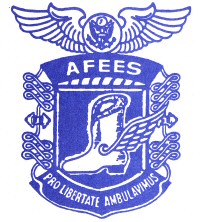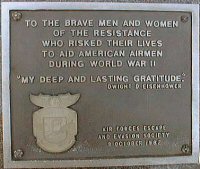AFEES has more than 600 regular members from most wars, primarily World War II. To be eligible for membership, a person must have been a United States airman and must have been forced down behind enemy lines and avoided captivity, or escaped from captivity to return to Allied control. In addition to regular membership, other categories of membership are Helper Members, and Friend Members. |
 about our patch |
 |
The purpose of the
AFEES is to encourage airmen aided by resistance
organizations or patriotic nationals of foreign
countries to continue friendships with those who
helped them. Helper members are people who either
directly aided the airmen or are family members of
helpers. "Our organization perpetuates the close bond that exists between airmen forced down and the resistance people who made our evasion possible at great risk to themselves and their families," says Larry Grauerholz, editor of the quarterly AFEES Communications journal. |
The History of AFEES dates back to 1964
Before 1961, a Frenchman by the name of Leslie Atkinson, a Reserve Captain in the French Air Force, a member of the executive committee of the Army Resistance Organization, and a Helper for Allied airmen, was inspired by the brilliant work accomplished by the British Royal Air Forces Escaping Society. It became his mission to create an association that would bring together American aviators who had escaped from enemy-occupied territory and their European Helpers.
With the help and advice of many people, Mr. Atkinson's efforts resulted in the Air Force Rescue Association being organized in France. By July 1, 1963, the project had been approved by the US Embassy in Paris, the US Air Force in Europe, and the President of the French Republic. Leslie's personal determination to fulfill his objective kept him going. He advertised in Europe and found many Helpers; he advertised in the States and received a few replies.
In early 1961, Ralph Patton went back to France and traced his escape route to Guingamp. There he met Mathurin Branchous, the provincial Resistance leader who had a list of names and last-known addresses of Americans who had escaped by way of Operation Bonaparte. When he returned home, Ralph contacted two other men on the list: John T Emery and Fred Schmitt. The three men proceeded with plans for a reunion in Buffalo, NY, on May 15-16, 1964, to honor their war-time benefactors.
Letters went out and encouraging responses were received from evaders. Counting family members, 56 people attended the Buffalo reunion, including 32 evaders, 7 helpers and 1 from Canada. That list was the origin of the US Air Forces Escape & Evasion Society roll.
In the January 1964 issue of the VFW magazine, Leslie's notice appeared on the same page with one from Ralph K Patton seeking contacts from "those who escaped from Plouha on the Northern coast of Brittany." Contact was established between Ralph and Leslie and they began to communicate about their common interests. Mr Atkinson gave Ralph the names of airmen he had in the US and Leslie concentrated his efforts with the helpers he had identified in Europe. Leslie Atkinson extended his contacts in Europe beyond France. He corresponded with officials in Belgium, Holland, Norway, Italy and other nations. Belgium, thanks to Comète, sent a delegation of 61 to the U.S. in 1974 for celebrations in Detroit, Washington and New York City. Ralph Patton also developed ties with the Royal Air Forces Escaping Society of Canada which resulted in a joint reunion in Toronto in 1995, a memorable event for all involved.
The AFEES list contained 33 names at the 8th Air Force Historical Society meeting in Phoenix in 1979 and 50 a year later when the 8th met in Orlando. In 1982, 28 helpers attended the meeting of the 8th in Cincinnati. That was when Scotty David went to work to locate evaders in the US. Armed with a list of 3,000 names, she began her search. By 1986, AFEES had about 400 members and held the society's first annual meeting in Atlanta with 170 in attendance. By dint of personal perservance and hundreds of letters and telephone calls, Scotty somehow continues to discover new members. Membership reached 949 in 1994, including some 175 men from the 15th Air Force and other units not on the original list.
Nearly 60 years after World War II, members continue to be located. The current list of known helpers world-wide now exceeds 600.
AFEES Communications, published quarterly, is the official Journal of the Air Forces Escape & Evasion Society. AFEES is a tax-exempt Veterans organisation under IRS Code 501 (C)(19). It was founded in 1964 and is Chartered in the State of Georgia.
For more information on AFEES, call Larry
Grauerholz at (940) 692-6700 or e-mail afees44AThotmail.com
(we're fighting
junk emailing - please replace AT with @ before sending)
Reunions - see AFEES' own website www.airforceescape.com
The Future
Richard M Smith, President, writes in the Spring 2009 issue of Communications:
This might well be the last letter you will receive from your current president.
Wheels are in motion to retire the AFEES Flag and present it to the Air Force Museum, Dayton, Ohio, where it will proudly fly in the Rotunda with other retired military flags.
The ceremony for this retirement is very respectful and very interesting. As it should be!
Some 45 years ago, in the fall of 1964, a small group of American airmen were invited by Ralph Patton and Bill Spinning to attend a meeting in Niagara Falls, N.Y., to consider forming a group of evaders in the United States.
This first group consisted of airmen who had evaded via the water route from the Brest Peninsula, France, to England.
By word of mouth the good news spread and soon AFEES had members from several air forces.
After several years, the Clayton Davids became members, got very interested in evaders from all of the U.S. Air Forces. At one time AFEES had nearly 1,000 members.
Now with the median age of an AFEES evader member hovering around 85, it became evident that a change had to be made.
The decision was made to disband AFEES at the Wright-Patterson Air Museum at the 2009 annual meeting.
It is with a shaky hand and a heavy heart that I write these last lines.
RICHARD M. SMITH
The
significance of elements of the AFEES patch
|
 |
The need for a symbol or logo for our group was discussed following the first reunion held in Buffalo, N.Y., on May 15-16, 1964. At that reunion, the only identification we had was a plastic enclosed name tag and we felt a permanent emblem or crest was needed.
The blue background represents the blue sky in which we flew. Blue was also chosen since the then-recently former separate Air Force had selected a blue uniform to differentiate it from the old U. S. Army Air Force uniform.
Since we all wore wings representing different positions or duties in the airplane, it was decided to use a common or generic type of wing. The shield of the United States of America is enclosed in a circle for the center of the wings. Silver metallic thread was used since our wings were made of a silver compound.
AFEES is an acronym for Air Forces Escape and Evasion Society. The plural of Air Forces was chosen to provide eligibility to men from all air forces. All founding members had been assigned to the 8th Air Force in England.
Small shells on either side of the emblem represent sea
shells on the shore of Plage Bonaparte.
The winged boot in the center signifies that members walked
back from their last mission: Fly out, walk back.
We felt that whether an airman walked across the mountains or
came out by boat, the winged boot was appropriate for all.
The Latin phrase at the bottom: PRO LIBERTATE AMBULAVIMUS
translates to FOR LIBERTY WE WALKED.
The emblem was first available in about 1966-67 and was worn on our trip to Europe in 1969. It was suggested that the patch be worn on a navy blue blazer. A pair of gray slacks was suggested to be worn to complete the 'uniform'. The original design was submitted by Harry L Minor, E&E# 421, who walked over the Pyrenees into Spain in 1943.
This page was provided by Royal Air
Forces Escaping Society 1945-95
website editor Frank Haslam.
Last updated and closed 8 Apr 2010.
The AFEES now have their own website www.airforceescape.org
However, visitors to this page are invited to look
at the Sherwood Register
via the Fréteval Forest link on the RAFES
1945-95 website.
